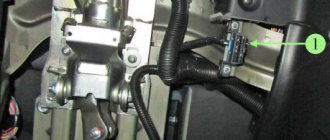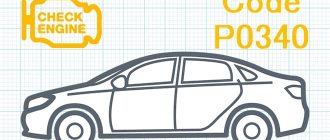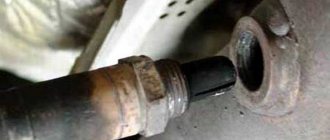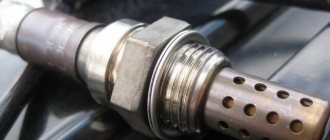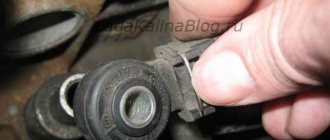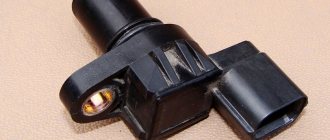What does P0030 mean?
Trouble code P0030 is a general trouble code that indicates that the engine control module (ECM) has detected a malfunction in the oxygen sensor 1 (bank 1) heater circuit. The vehicle's ECM uses an oxygen sensor to monitor the oxygen content of the vehicle's exhaust gases. The ECM uses the signal received from the oxygen sensor to regulate the fuel/air mixture ratio of the engine. The most optimal ratio of air and fuel in the mixture supplied to the engine cylinders is 14.7:1. It is this ratio that is necessary to achieve maximum engine power and optimal fuel consumption.
The oxygen sensor heater is used to heat the internal components of the oxygen sensor to provide faster feedback to the vehicle's ECM. This is necessary to reduce emissions of harmful substances from the vehicle's exhaust gases when starting the engine, especially if the engine is started in a cold state.
How to find a fault
Checking the positive contact of the oxygen sensor heater
First of all, it is worth checking the voltage in the connecting block of the first lambda and the presence of oxides; it happens that after cleaning the contact with a special product, the problem goes away. It is also worth checking the performance of the sensor itself by measuring the resistance.
To check the lambda probe wire, you need to disconnect two parts of the connecting block. We do not touch the part that goes down to the “female” sensor, but take measurements on the “male” block, the wires of which lead to the ECU.
With the ignition on, use a multimeter to check what voltage is supplied through the wires from the computer to the sensor heating element. To do this, select the voltage measurement mode of 20 V on the device and take readings on the contacts one by one. We attach the black probe to ground to the body, and connect the red probe to the upper right contact (if the block is not twisted, this will be the positive contact of the sensor heater). It should show a little more than 12 V. The diagonally opposite, lower left contact also goes to the heater and it should show a voltage of no more than 3.27 V.
When connected to the upper left contact, the multimeter will show a very small value - 0.02 V. After this, connect the probe to the opposite, lower right contact - there the voltage should be about 0.45 V. This is the contact of the oxygen sensor, which analyzes the level of oxygen in the exhaust gases and transmits the reference voltage directly to the ECU. After this, the system adjusts the fuel-air mixture based on the data received.
The oxygen sensor reference voltage should always be checked with the engine warm!
You can also check the male block by selecting the ringing mode on the multimeter. If all contacts ring, then the wire is in normal condition, and the problem most likely lies in the oxygen sensor itself.
To check the lambda probe itself, select the resistance measurement mode of 200 Ohms on the multimeter. We connect the red probe to the upper right contact, and the black one to the lower left , both go to the lambda heater (on most cars these wires are white). Normally, the resistance of the working sensor should be 3.3-3.5 Ohms. More details about checking the lambda probe can be found using the example of Ford Mondeo 1 here.
How does a mechanic diagnose a P0030 code?
First, the mechanic reads all the stored data and error codes using an OBD-II scanner. He will then clear the error codes from the computer's memory and test drive the vehicle to see if P0030 appears again. If the error code appears again, the mechanic will visually inspect the heated oxygen sensor for damage, as well as check the ground and measure the voltage at the sensor.
The mechanic will then carefully check any associated electrical wires that may have been damaged due to excessive heat due to high exhaust temperatures.
Instrument cluster diagnostics
You can diagnose faults on your car. To do this, turn on the ignition while continuously pressing the Reset button. Next, the LCD is monitored and all segment positions are displayed on it. Now you need to activate the button closest to you on the control panel, after which the version of the firmware made should be displayed on the screen. Press any control button again. If there are errors in the Lada Granta, special digital symbols should be displayed on the first two lines of the screen, which, in turn, may indicate various malfunctions.
Presence of increased voltage in the on-board system. If within 20 seconds the on-board computer was unable to detect a malfunction in the Lada Granta, then three significant error signals may occur. The first in this case indicates an open circuit in the sensor responsible for reading the fuel level. The second reacts to an open circuit in the sensor circuit that responds to the coolant temperature. And the third detects errors when the outside temperature sensor circuit is broken, which is within minus levels.
Next come error signals that directly indicate that the engine has overheated, emergency oil pressure levels, a defect in the brake system, or a completely discharged battery.
Errors in the data packet are detected. To clear error codes, press and hold the Reset button for a few seconds. Now press any of the control buttons, thanks to which the LCD control will start and all the necessary segment positions required for high-quality control will light up.
How serious is P0030?
When a P0030 error occurs, the Check Engine light on your vehicle's dashboard will illuminate, indicating a problem. Failure of the heated oxygen sensor may cause the vehicle's ECM to not be able to properly regulate the fuel/air mixture in the engine. The vehicle's engine may run erratically. It may also increase fuel consumption and damage other vehicle components. If this code is detected, it is recommended that you contact a qualified technician as soon as possible to diagnose and resolve the error.
Often, if the Check Engine Light comes on immediately after starting the engine, the OBD-II system can be reset and the vehicle will continue to operate normally.
Reasons for the error
If the diagnostic scanner detected code P0030 immediately 30 seconds after the engine started, this may indicate several common causes.
Main reasons:
- A break in the wire of the first lambda sensor or lack of contact in its connector.
- The lambda wire is shorted to ground.
- The sensor heater fuse has blown (mostly installed on VAG models).
- The oxygen sensor heater itself is faulty - check the resistance (should be no less than 3 Ohms and no more than 35 Ohms).
- The type of sensor does not match the standard one installed from the factory - check and replace with a suitable one. This problem often occurs on Subaru cars when an analogue lambda is installed; the error can be eliminated only after replacing it with the original.
- The data bus to the controller that controls the sensor is faulty. Or an incompatible controller is installed - replace the ECU.
- The controller has the wrong firmware installed.
Where to look for a fault
In some cases, the P0030 code may be displayed without any disturbance in the vehicle's dynamics. All systems are working normally, the flow rate does not change, but the code is generated. In this case, you need to check several main possible causes of the error:
- The wire may break in the area from the probe to the connecting block. You need to disconnect the connector and check the contacts with a multimeter. If the sensor is in order, then it should ring without problems.
- The wire in the area from the connecting block to the ECM may be frayed or one contact may be broken. You also need to remove the wire and check whether the contact is coming to the block - whether there is resistance.
- The problem is in the block itself. For example, the VAZ 2114 has the 2111-1411020-81 January 7.2 unit installed, which is characterized by the problem of the TLE6240GP B1 chip burning out. To solve the problem, you will have to take the unit to a specialist so that he can resolder this microcircuit, since they can often fail. The price of the microcircuit itself is on average from 300 to 500 rubles.
What repairs can fix the P0030 code?
To resolve the P0030 error you may need to:
- Clearing error codes from the ECM and test driving the vehicle to see if the P0030 code appears again
- Heated Oxygen Sensor 1 (Bank 1) Replacement
- Repair or replace electrical wires or connector for heated oxygen sensor 1 (bank 1)
- Replacing the fuse in the oxygen sensor 1 heater circuit (bank 1)
- In rare cases, replacing the engine control module (ECM)
Recovery
Is it possible to restore a broken sensor? This can be done only in one case - if the cause of the malfunction is poor contact and the sensor itself is working normally. You can also try removing the carbon deposits inside. But to do this, you need to take the sensor out and lower it into an aggressive environment (white spirit or gasoline).
Please note: do not use sandpaper, needle files or other rough objects for cleaning. To avoid damaging the tip, use a soft cloth soaked in solvent. By treating the sensitive element with white spirit, you can restore the functionality of the sensor. But it is not a fact that after cleaning it will take accurate measurements. Ideally, this element should be changed entirely. Fortunately, the operation is simple, you can do it yourself. We’ll tell you exactly how below.
Additional comments for troubleshooting P0030
Many high mileage vehicles (usually over 150,000 kilometers) have short-term problems with sensors, which usually occur when the engine is started or the transmission is subjected to prolonged stress. Often, if the Check Engine Light comes on but the vehicle continues to operate normally, the OBD-II system can be reset and the problem will be resolved. This is why it is important to check for an error code using a scanner and clear the code from the computer's memory before performing any repair work.
Meaning and interpretation of error codes
Error codes in the form of one and two-digit numbers:
| P0340 |
Combinations of problems when performing computer diagnostics are displayed in four-digit form:
| Code | Description and recommendations for elimination |
| 1 | Malfunctions in the operation of the control module. The unit is subject to more thorough checking for possible problems. Problems can be both hardware and software in nature. Before performing the test, it is recommended to clean the module connector and diagnose the integrity of all wires so that the signal from the device is correct. |
| 2 | Malfunctions related to the functioning of the wiring of the fuel volume sensor in the tank. The device may produce an incorrect signal, which is often due to damaged or clogged contacts on the block. It is necessary to diagnose the sensor and also check the integrity of the wiring. |
| 4 | The control unit has detected an increase in the voltage level in the car's electrical network. The problem may be due to a low battery (when the charge decreases, the generator runs faster) or a malfunction of the generator set. You need to check the voltage regulator relay. If the battery (rechargeable battery) is discharged, it must be recharged. |
| 8 | Reduced voltage in the vehicle's electrical network. The problem is solved in a similar way - by diagnosing the generator set and battery. |
| 12 | Malfunctions associated with the operation of the diagnostic electrical circuit of the lamp on the instrument cluster |
| 13 | The microprocessor module does not allow you to determine the pulse coming from the lambda probe. The oxygen sensor is subject to diagnostics. |
| 14 | The antifreeze temperature sensor sends too high a signal to the control unit. The controller may not work correctly for the following reasons:
All elements are subject to diagnostics. |
| 15 | Malfunction related to the coolant temperature sensor (coolant temperature sensor). The controller needs to be checked because the signal from it is too high. |
| 16 | Another error indicating high voltage in the vehicle’s on-board network |
| 17 | Low voltage in machine wiring |
| 19 | The control unit reported problems with the functioning of the crankshaft position controller. The device is sending an incorrect signal. If the sensor is faulty, it may be difficult to start the engine. Sometimes the power unit does not start at all. |
| 21 | Failure associated with the functioning of the throttle position controller; there may be problems with the operation of the unit itself. If the sensor is faulty, the car engine may not operate correctly and power may be reduced. |
| 22 | A low signal is sent from the throttle position controller to the control unit |
| 23 | Incorrect pulse received by the microprocessor from the intake air temperature controller |
| 24 | The speed sensor is malfunctioning. If the controller fails, the speedometer will not function. |
| 25 | An incorrect signal is being sent from the incoming air flow temperature controller |
| 27, 28 | The control unit receives an incorrect pulse coming from the CO controller |
| 33, 34 | Error codes indicating problems with the mass air flow controller. You need to check the sensor wiring and the device itself. If the MAF (mass air flow sensor) is faulty, the engine may stall randomly and its power will be reduced. |
| 35 | The microprocessor module recorded a deviation in idle speed. You need to check the XX regulator and its connector. |
| 41 | Incorrect signal supplied by the phase regulator. It may be too low or high. |
| 42 | Malfunctions related to the electrical connection circuit of the electronic ignition system |
| 43 | The control unit has determined that the knock sensor is inoperable; an incorrect pulse transmitted from the device is possible |
| 44, 45 | Problems with the air-fuel mixture - too lean or rich |
| 49 | Vacuum Loss Diagnostic Code |
| 51, 52 | Malfunctions associated with the operation of one of the memory blocks - RAM (random access memory) or PROM (read-only memory) |
| 53 | There is no signal from the CO sensor to the microprocessor. There may be a break in the electrical circuit or failure of the controller. |
| 54 | There is no signal from the octane corrector sensor |
| 55 | The engine control unit detects a lean mixture when the load on the car engine decreases |
| 61 | Malfunctions related to the operation of the oxygen sensor. The lambda probe must be replaced. |
| Error code | Decryption and recommendations for elimination |
| 0030 | The microprocessor unit detected faults in the power line in the area from the oxygen controller to the neutralizer device. |
Wiring and regulators are subject to diagnostics. Failed devices are replaced.
It is necessary to check the integrity of the circuit and the regulator itself.
The wiring through which the device is connected, as well as the regulator itself, are checked.
You need to look for the source of the problem in the device itself or its electrical circuit. Often the cause of the malfunction is due to liquid getting on the block to which the sensor is connected.
The throttle position controller is giving an incorrect signal. There may be interference in the electrical circuit if the line is damaged.
The device is subject to detailed testing and replacement if necessary.

